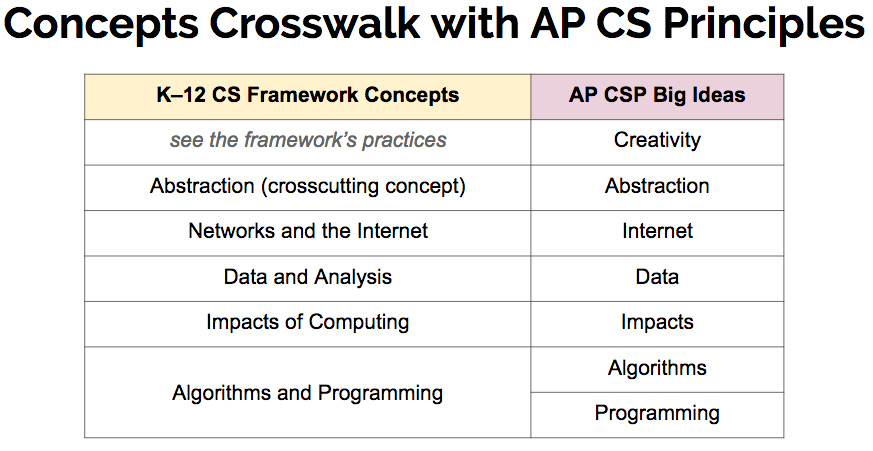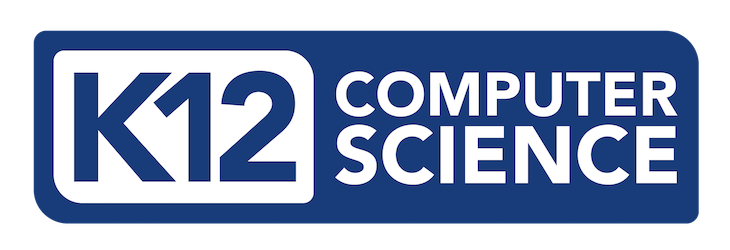About the Framework
What is the framework?
The framework is a baseline, essential set of computer science concepts and practices. The focus of the framework is to illuminate powerful ideas in K–12 computer science. Each of the core concepts are delineated with expectations at four different grade band endpoints: Grades 2, 5, 8, and 12. The practices are not delineated by explicit grade bands but instead provide a narrative describing each practice’s progression from kindergarten to Grade 12.
Where can I find the framework?
You can download a copy of the entire framework (all chapters, including guidance material) as a pdf here. Just want the concepts and practices? Click on “Framework Statements” in the main menu to access the dropdown menu and select one of the three views. From each page, you can download a pdf of the concepts and practices.
Why do we need a framework, and why is it important?
Computing is all around us in the modern world, yet many students do not understand how these technologies work. Interest in computer science is increasing, and K–12 education is eager to meet the demand. However, computer science is fairly new to K–12 education, and states, districts, schools, and teachers need guidance for an appropriate K–12 pathway in computer science.
What is the vision of the framework?
The purpose is to create a high-level framework of computer science concepts and practices that will empower students to
- be informed citizens who can critically engage in public discussion on computer science-related topics;
- develop as learners, users, and creators of computer science knowledge and artifacts;
- better understand the role of computing in the world around them; and
- learn, perform, and express themselves in other subjects and interests.
What is computer science?
Computer science is the study of computers and algorithmic processes, including their principles, design, implementation, and impact on society (Tucker, 2006, p. 2).
Who is the framework for?
The K–12 Computer Science Framework informs state- and district-level decisions to introduce and improve computer science education. The framework was written for a variety of audiences with a wide range of backgrounds in computer science. The primary audiences of the framework are state policymakers and administrators, district policymakers and administrators, standards developers, curriculum developers, professional development providers, researchers, and current and new computer science educators in both formal and informal settings.
Why is computer science important?
Computer science underpins many aspects of the modern world. The ubiquity of personal computing in our lives and our exponentially increasing reliance on all things related to technology have changed the fabric of society and day-to-day life. Unfortunately, K–12 students today have limited opportunity to learn about these computer science ideas and practices and to analyze how computing influences their daily lives.
What are the core concepts and practices of the framework?
The core concepts are categories that represent major content areas in the field of computer science. They represent specific areas of disciplinary importance rather than abstract, general ideas. The core practices are the behaviors that computationally literate students use to fully engage with the core concepts of computer science.
Core Concepts
Computing Systems
Networks and the Internet
Data and Analysis
Algorithms and Programming
Impacts of Computing
Core Practices
Fostering an Inclusive Computing Culture
Collaborating Around Computing
Recognizing and Defining Computational Problems
Developing and Using Abstractions
Creating Computational Artifacts
Testing and Refining Computational Artifacts
Communicating About Computing
The Framework’s Development
Who created the framework?
The steering committee for the framework consists of representatives from the following organizations: Association for Computing Machinery, Code.org, Computer Science Teachers Association, Cyber Innovation Center, and National Math + Science Initiative. The writing team was composed of representatives from participating states, school districts, K–12 educators, higher education faculty, and research and nonprofit organizations (you can see their biographies here or in the complete framework under Appendix E: Biographies of Writers and Development Staff). Leading researchers and representatives from organizations in computer science education served as advisors to the writers and the development staff. More than 100 computer science education practitioners and stakeholder organizations served as reviewers, with more than 530 reviews submitted.
Were teachers involved in the framework's development?
Many of the writers were current teachers or had been teachers in the past. Their experience spanned kindergarten through Grade 12 and included a variety of subjects outside of computer science. Some of the advisors were teachers, many of the development staff were former teachers, and teachers were included in review periods and in focus groups during the development process.
How were states involved in the development of the framework?
For each of the involved states, representatives from the state department of education and board of education attended the stakeholder convenings to provide feedback into the development of the framework. The ten states that participated in the launch of the framework’s development were asked to nominate someone from their state to serve on the writing team and to convene a group to review the drafts of the framework in their state.
How was the public involved in the creation of the framework?
Three public review periods were held during the development of the framework in 2016. Each lasted two to three weeks, and each was publicized widely to encourage the public to read the draft versions and submit feedback via an online form. The feedback that was received was read by the writers and development team, and common themes were addressed by the writers. You can read more in the Development Process chapter and see a summary of the public reviews in Appendix A: Feedback and Revisions.
How does the K–12 Computer Science Framework relate to AP Computer Science Principles?
AP Computer Science Principles (AP CSP) represents a college-level introduction to computer science and influenced the development of the K–12 Computer Science Framework. Many of the writers and advisors of the K–12 Computer Science Framework were involved in the development of AP CSP. See a crosswalk between the two documents below:


How was research used to inform the development of the framework?
The writing team considered the current literature on computer science education from the start of the writing process. After the second draft of the framework was complete, a systematic review of the literature related to the concepts and practices was completed. From this review, concept and practice statements were tweaked to align them with the current research in the field. You can read more in the The Role of Research in the Development and Future of the Framework.
The Framework and Standards
What is the relationship between the framework and standards?
The framework broadly delineates the concepts students should know and the practices students should exhibit, but it does not provide the level of detail of grade-by-grade standards, course objectives or descriptions, or lesson plans. Instead it serves as a comprehensive guide for the development of standards, curriculum, assessments, teacher education, and extracurricular programs. The framework is not a set of standards. States may use the framework to develop standards that will combine the concepts and practices into performance expectations that are clear, specific, and measurable.
How is the framework different from national standards?
- The framework statements are not standards. They are purposefully not as prescriptive or measurable as performance standards. They do not address individual grade-level granularity; instead, they address grade bands and describe how learning progresses from one grade band to another.
- There are far fewer statements in the framework than in a standards document. The focus of the framework is to provide a minimum set of concepts and practices that describe baseline literacy in computer science that all students should have. An explicit goal of the framework is to show significance/application beyond computer science and significance for every citizen, not just computer science students.
- The framework is intentionally designed for customization and will be freely available. It describes what students should learn using nontechnical prose that is easy to understand by a wide audience. States and districts should make the final decision on the documents they use when developing their own computer science standards.
- The framework distinguishes between concepts and practices. A standards document should integrate these two dimensions into each standard.
You can read more about how the framework can inform the development of standards in the Guidance for Standards Developers chapter.
What is the relationship with the Computer Science Teachers Association (CSTA) K–12 standards?
The K–12 Computer Science Framework served as one of many inputs into the interim 2016 revision of the CSTA K–12 computer science standards to ensure alignment and allow for the computer science education community to speak with a coherent voice about what K–12 students should know and be able to do. The co-chairs of the CSTA standards revision task force served as advisors to the framework, and half of the CSTA standards writers (including all of the CSTA lead writers) served as writers of the framework.
Miscellaneous
Are future revisions of the framework planned?
It is anticipated that the framework will be revised in the future. Furthermore, the framework is licensed under a Creative Commons license that allows for adaptation.
How does the framework address computer literacy and digital citizenship?
The framework defines K–12 computer science, which is different from digital citizenship and computer literacy. Digital citizenship is defined as the norms of appropriate, responsible behavior with regard to the use of technology (Massachusetts Department of Elementary and Secondary Education, 2016). Computer literacy focuses on the use of existing technologies and computer programs like word processing and spreadsheets (National Center for Women & Information Technology). Computer science, on the other hand, is about “the ability to create and adapt new technologies” and involves analyzing how computers work and how they affect us (NCWIT). The K–12 Computer Science Framework is meant to complement the instruction of computer literacy and digital citizenship. Instruction in all three areas is important for all students.
How does the framework address computational thinking?
Computational thinking can be defined as “the human ability to formulate problems so that their solutions can be represented as computational steps or algorithms to be executed by a computer” (Lee, 2016). It is delineated in four of the seven computer science practices in the framework. Computer science offers a unique opportunity for students to develop computational thinking, but the opportunity to apply computational thinking extends beyond the context of computer science. Recent revisions to the 2016 International Society for Technology in Education Standards for Students are aligned with this definition of computational thinking. These documents support the shared vision that computational thinking is important for all students in all classes.
How is the framework implemented in schools?
The framework can be used in a variety of ways. It can inform curriculum development, standards development, K–12 pathways, teacher preparation and professional development, and classroom assessment, among others. It can be implemented as standalone courses or integrated into other subject areas, particularly at the elementary and middle school levels. You can read more in the Implementation Guidance chapter.
If I want help using the framework, whom should I contact?
You can reach out to the development staff with your questions using this form.
